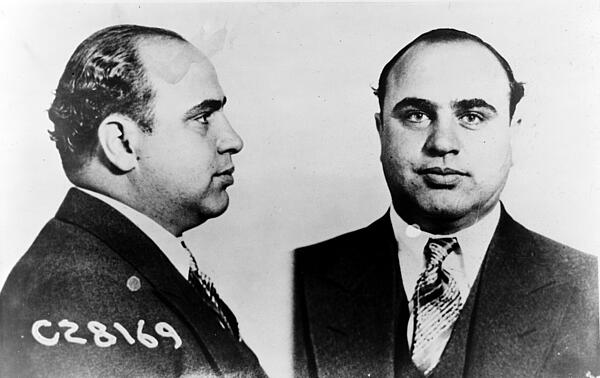Prohibition and the Gangsters
Along with Jazz music and mass consumption, prohibition and gangsters very much defined 1920s America. Bootlegging became more popular as a way of getting around the ban on alcohol. This hugely increased the rate of organised crime and led to a rise in gangsterism.
Under the 18th Amendment, which was introduced in 1920, it became illegal to make, move or sell alcohol. It represented a conflict between the conservative values of rural Americans and new urban values.
The Amendment met lots of resistance with America and as such a black market developed as people were keen to get their hands on the outlawed produce. Across America, the major cities each had their own a gangster organisation that controlled bootlegging operations. The most famous of these gangsters was Al Capone, who operated in Chicago.
As prohibition took hold, Capone’s notoriety quickly grew and over time the gangster became arguably the greatest symbol of the collapse of law and order in the 1920s. In 1920 Capone made the decision to pack up and move to Chicago. Once he was in the city a young Capone began to for the head of the criminal underworld: Johnny Torrio.

In his role working for Torrio Capone was responsible any rival gang, ensuring that his mob at the best territories and the most business, including making sure Torrio was the main source for any speakeasy serving alcohol.
Charismatic and ruthless, Capone became a hugely successful in the gangster underworld. In 1925, Torrio passed the reigns of his business over to Capone.
Within just two years, it is reported that alcohol sales by themselves were earning Capone an annual income of around $60 million a year. He would earn a further $45 million per year through various other racketeering operations.
One of the key techniques Capone used to maintain his power - as well as to keep himself out of jail - was to bribe important authorities and politicians. It is believed that Capone spent as much as $75 million on keeping the right people sweet, but as detailed above, he could afford to in order to keep his business empire running smoothly.
Big Bill Thompson became the Mayor of Chicago after 1927. He was one of the men that Capone bribed heavily. Thompson said:
"We'll not only reopen places these people have closed, but we'll open 10,000 new ones (speakeasies).”
However, despite being one of powerful men in the city, Capone was not without his enemies, namely from rival gangsters. Such was the risk he faced that he took to travelling around the city in an armour plated limousine. But he was not being paranoid - his fears were very real. Indeed, it is reported that in the late 1920s in Chicago there 227 gangsters killed over just a four-year period. Famously, on St Valentine's Day 1929, Capone’s men shot dead seven members of the O'Banion gang - this became know as The Valentine’s Day Massacre.
The law eventually caught up with Al Capone though and in 1931 he was charged with tax evasion. He was sentenced to 11 years in prison. However, while in jail his health failed and when he was released, he retired to his Florida mansion.
See also: Causes of the Great Depression
MLA Citation/Reference
"Prohibition and the Gangsters". HistoryLearning.com. 2026. Web.
